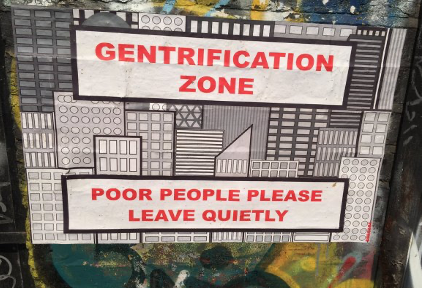Gentrification is defined as the process of changing the character of a community through the influx of more affluent residents and businesses. British sociologist Ruth Glass was the first to use the term “gentrification” in the 1960s to describe the influx of middle-class people displacing residents in London’s working-class neighborhoods. Gentrification has been around for over 50 years and is increasing nationwide. In the 1960s/70s it was called Urban Renewal in the US, but Black people called it “Negro Removal” because that’s what it did. The road to gentrification is paved with years of redlining, discrimination in lending and housing, intentional systemic disinvestment, and government/ institutional neglect.
fe
The Gentrification Process
The gentrification process includes the displacement of lower-income residents; the physical transformation of the community through the upgrading of housing stock and commercial properties; and changing the cultural identity of the community. Typically, gentrification occurs when an influx of investment in a lower-income community is followed by rising property values and higher incomes and educational levels of new residents. It’s often accompanied by cultural displacement when affluent, white gentrifiers replace longtime Black and Latinx residents. Cultural displacement occurs when the preferences and norms of new residents replace those of longtime residents. This often includes the loss of historically and culturally significant community institutions.
fe
Examples of Gentrification
Classic examples of communities that were gentrified decades ago include Washington, D.C’s Georgetown, Philadelphia’s Society Hill, New York City’s SoHo, and Baltimore’s Federal Hill. In the 1960s, South Philadelphia, just below Center City and east of Broad Street, was a community of primarily working-class Black and white residents until the planning of the Crosstown Expressway. Eminent domain was declared to obtain land for the new highway, and longtime homeowners were offered a few thousand dollars for their row houses. Thanks to years of protest by resident activists, the Crosstown Expressway never materialized, but most of the working-class residents were displaced. Blocks of row houses were transformed into upscale townhouses. The community was repopulated with upper-income whites and renamed Society Hill. Those who tried to keep their homes eventually left due to rising property taxes. Further gentrification in Society Hill took place in the late 1980s and 1990s when public housing was demolished, and the art galleries, artsy boutiques, shops, and creative businesses were forced to close by landlords who raised the rents and replaced them with more mainstream, upscale businesses and condos. Gentrification in South Philly later moved west of Broad Street and further south to Point Breeze.
fe
NCRC Study
A 2019 study by the National Community Reinvestment Coalition (NCRC) found that seven cities accounted for nearly half of the gentrification nationally — New York City, Los Angeles, Washington, D.C., Philadelphia, Baltimore, San Diego, and Chicago. The study found that Washington, D.C., was the most gentrified city by the percentage of neighborhoods that experienced gentrification and New York City was the most gentrified by volume. Gentrification was centered on downtown business districts and the surrounding communities. Displacement of Black and Latinx residents accompanied gentrification in many cities. The NCRC study found that between 2000 and 2013, many major cities showed signs of gentrification accompanied by racialized displacement. According to the study, between 2000 and 2010, the losses of Black residents in Washington, D.C., New York City, and Philadelphia were especially high due to the large number of displaced residents. More than 20,000 Black residents of Washington, D.C., 15,000 in New York City, and 12,000 in Philadelphia moved out of gentrifying neighborhoods. While living in DC during the 1970s, I remember the boldness of early gentrifiers who built upscale townhouses directly across the street from a “house of ill repute” in a Northwest community close to downtown, because they knew it would soon be gone due to higher property taxes.
Currently, in other parts of Philadelphia, gentrification and the expansion of local universities have displaced residents in West Philly’s Mantua and Parkside, and communities throughout North Central Philadelphia. Gentrification has also infiltrated Fishtown – once a white working-class community–and is now focusing on drug-infested Kensington. Philadelphia’s 10-year property tax abatement on new housing and questionable city zoning decisions have been beneficial to gentrifying developers.
fe
Take Action
Displacement due to gentrification is devastating to families and causes a disruption of the entire community. It affects school attendance, access to health care, jobs, affordable housing, social supports, and community institutions. Changes in the demographics of a community eventually transform its cultural, economic, and political make-up and outcomes. Politicians take heed. The people who elected you may soon be gone.
Where will displaced people go, and what can we do to fight gentrification? No community is safe from gentrification. Quiet as it’s kept, gentrification is even moving into the suburbs. The best advice? Communicate with your neighbors and organize; attend zoning meetings; confront your elected officials; demand affordable housing; support community institutions; join or form a tenant’s union, and develop and support public banks and community land trusts.
Decent and affordable housing is a human right. People need to get serious about organizing and working to preserve their communities because gentrification may soon be knocking on your door.
Gentrification: Economic change, discrimination and cultural displacement
Reading Time: 3 minutes


